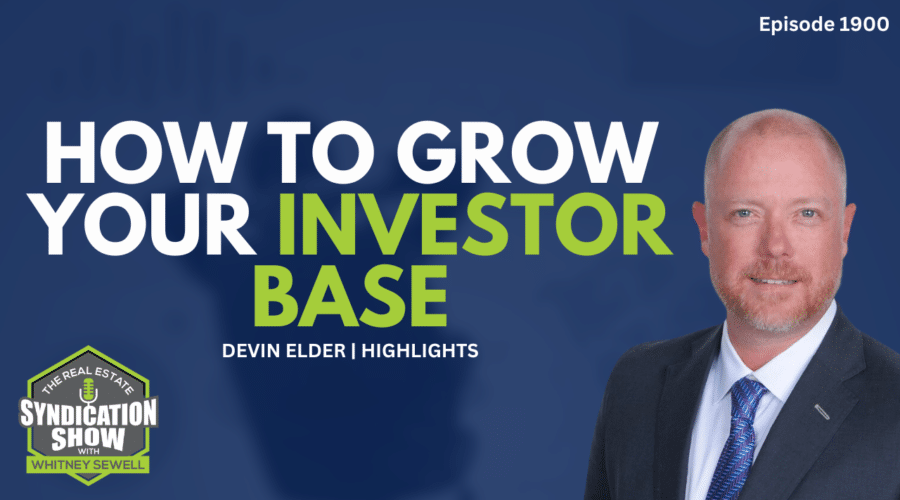Capital raising is one of the most critical building blocks of any real estate business. A syndicator, for instance, will always seek investor funds to purchase and operate a rental property. While the ability to find the right deal in the right market is crucial to success in syndication, it is equally – or even more – important to develop and master the art and skill of raising funds.
In one of my conversations with Hunter Thompson, Managing Principal at Asym Capital and author of Raising Capital for Real Estate: How to Attract Investors, Establish Credibility and Fund Deals, we discussed this topic in detail. I’d like to share with you now some key strategies and ideas to build your brand and credibility and bolster your foundation for capital raising. Click here if you want to listen to the full podcast episode.
Build Credibility and Trust
Most investors, especially the ones that invest capital into partnerships and syndications, would first be concerned about whether or not they can trust you with their money, and whether you’ll deliver on what you say. So, even before pitching a deal and asking for financial backing, you have to earn their trust.
It’s often said that the real estate business is a business of relationships, and I encourage you not to take this for granted. People do invest in people. When all else is equal, a potential investor will prefer a sponsor that they like, and more importantly, trust. With this knowledge, syndicators must then be more intentional in their efforts to build that relationship of trust with investors. So, you should start building your name, reputation, and credibility before courting potential sources of capital.
Build Your Credibility Platform
How do you build your credibility to gain investors’ trust? Hunter suggests creating an infrastructure to attract people who are already interested in these types of investments, and nurturing them through an educational platform. Your platform may take the form of a website, podcast, book publishing, blogs, vlogs, or meet-ups that will promote information about you and your real estate or financial background.
Whether you start a podcast, publish an e-book or a book, produce videos, write blog posts or newsletters, create social media posts, or produce webinars or run meet-ups, your platform will educate your audience about the real estate industry and bring your name and brand into their consciousness. Eventually, your digital footprint and social connections will establish your expertise and reputation in the industry and will provide your brand with lasting visibility as well as increased credibility.
Create Content
“The whole goal here is to create content, repurpose it, reuse it. If you’re already an expert in this space, you’ve done the hard part. Now it’s just a matter of getting it out of your head and then reusing it over multiple mediums,” says Hunter.
Why create an e-book?
Hunter advises syndicators to begin by creating an e-book. “From a conversion rate standpoint and from an educating-your-investor-base standpoint, there is nothing better than an e-book. It’s easy to make, just PDF and free to download from your website or sent by email,” he adds.
An e-book will allow you to go into detail both in written and visual format on your entire investment thesis – something that investors wanting to take an extra step of due diligence can easily grasp. Your e-book must be evergreen to the greatest extent possible, making it valuable to investors for a lengthy period.
How can I create an ebook?
If you’re already writing blog posts or doing podcasts, you can simply use the transcription – adding more details and graphics – and turn it into an e-book, suggests Hunter. “You can use that not only as a lead generation or a call to action but also reach out to other podcast interviews. It’s just reuse and repeat,” he adds.
Hunter suggests another method to generate content:
- Make an Excel list of 100 topics related to your business
- Rank topics according to current relevance, timeliness, preference, or the most-asked
- Write an article, about 1,000 to 1,500 words, about the first 10 topics.
- Take another 50 of those topics and write emails, between 300 and 500 words
- Send out the emails on Drip Campaign putting the best ones first
“It’s a really solid way to begin this process. Not only are people going to be attracted to you and learn through your educational platform, but you’re also going to be shocked as to how much you will learn just going through this process. The upside is incredible!” stresses Hunter.
By creating helpful and engaging content and then pushing it out into various mediums or formats, you can reach out to more audiences, expand your brand’s visibility and strengthen your credibility.
Get Yourself Out There
Get yourself on podcasts
Talk about your e-book and your expertise on podcast interviews. For newcomers in the business unskilled at interviews, it’s best to start in shows with smaller followings and move to bigger ones as you become more confident in the process.
Seize opportunities to mention your content (e.g. previous show episodes, e-book, blog posts, etc.) in conversations with people.
If you’re in a conversation and a topic related to your content comes up, say you will email them your e-book or send links to an article or show, advises Hunter. “Always circle back to different calls to action: “look at this article that I’ve written on this topic”, “check out this interview that I did in this topic” and your credibility starts to go up and up,” he adds.
Wow with Your Marketing Deck
“When it comes to your marketing deck (executive summary or offering deck), the name of the game is design, design, design. It is such a credibility booster to have a very well-designed marketing deck,” emphasizes Hunter.
Tips for creating your marketing deck:
Ensure that the file format is usable for presentation across multiple platforms like PowerPoint or Keynote. It’s important that you can convert the marketing deck into a format that can be used for webinars or live presentations.
The design is the absolute name of the game.
Hunter’s advice: If you don’t have an eye for design, hire someone that does. Get three competitors that you think are beautiful, send those to your graphic designer, and say, “This is exactly how I want them to look like.”
Most people make decisions based on emotion, so you want to tap into that and win investors over with your awe-inspiring design. “So, the first thing that people should say when you open the deck is: “Wow! This is beautiful.” That should be the response, not “Wow! This guy is really smart,” nor “Wow! These people know what they’re doing”. Those comments should come later when they start to get into the details,” explains Hunter. Stand out and put yourself at the forefront of investors’ minds with a fantastic marketing deck.
Record a Webinar
“Repurpose your content for a webinar presentation that people see over and over and over and it’s going to make your life a lot easier,” suggests Hunter.
Here are some tips before launching your webinar:
- Practice with mastery in mind
Record yourself first and then take an honest look at where you’re not as strong. Keep working on those weak points until you gain confidence.
- Have people sign up and RSVP to your webinar through eventbrite.com
Track RSVPs through eventbrite.com – this will also allow you to get their emails and include them in your mailing lists.
- Prior to the webinar, schedule 15 minutes for a tech check. Make sure the mic sound quality is excellent. Note: A high-quality microphone is a good investment. Remove extraneous background noises.
- Block an hour for the entire webinar. Allot the first 30 minutes for your presentation that goes over the key points of the executive summary (make sure you come in with a repurposed and much more brief version). Leave the last half hour for a Q&A.
- If no one speaks up during the Q&A, get the ball rolling with ten pre-written questions. You can say, “Well, someone emailed me these questions so I’ll go ahead and answer them.”
- Before your webinar, write thank-you notes to all that RSVP’d
After the webinar, send the thank-you notes – even to those that did not attend. Send the webinar recording as well even for people that were already there during the session. “Say – Here are the articles. You don’t like reading? Here’s the webinar. You don’t like watching and listening? Here’s the audio podcast. You’re reaching out to them via different senses in a much scalable manner,” advises Hunter.
Host an Investor Dinner and a Live Presentation
Now that you’ve hosted an online presentation in your webinar, you’ll have to be ready to do a live one in front of prospective investors. Invite 20 to 30 people who you believe are more likely to invest if they’re invited to become part of the experience surrounding their investment to a dinner presentation, all expenses covered by you. “The people that attend an in-person meeting are all about the actual functionality of the event, the vibe, the logistics, how am I going to be treated, what’s the overall experience?” shares Hunter.
Helpful tips for live presentations:
- Be very cautious about your internal thoughts. Visualize the positive outcome of the event but anticipate and prepare for things that might go wrong, such as a mic that won’t work, few people showing up, too many people showing up, or the check being late. Know how to overcome these mishaps and set systems in place to mitigate them.
- As the main event of the evening, you should embody the confidence and self-assuredness (minus the pompousness) that potential investors will pick up from you. Your behavior, manner, and speech should project the best of you. Investors will gauge you not only based on your professional background, but more on your personal qualities including your interpersonal skills, confidence, passion, and enthusiasm for your business, which all contribute to building a trusting relationship.
- Bring your pep team. Bring as many team members as possible to the event. Invite savvy investors who have invested with you previously. Knowing your support team is out there in the audience or in the background will boost your confidence. Your savvy investors can talk about how they got to know you and how they ended up investing with you and may influence others to do the same.
FINAL THOUGHTS
Building credibility and a strong brand isn’t easy. But with time, persistence, and a coordinated strategy, you can count on a steady rise in your rapport. In no time, you will be well on your way to confidently raising capital as a trusted syndicator in the world of multifamily investing.
–
Life Bridge Capital is here to guide you in the world of multifamily investing. If you’re interested, we’ll be happy to talk to you. You can email info@lifebridgecapital.com or click here and we’ll reach out to you.



